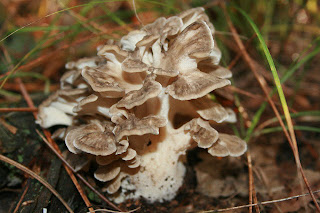Written by Rachel
Along with the change in colors and crisp, cool wind, fall in Wisconsin also brings a plethora of fresh vegetables and a new flush of wild and cultivated maitake (Hen of the Woods). This particular mushroom has a leafy, almost coral like or extraterrestrial appearance and a fresh peppery scent (no, its not straight from a Lewis Carroll tale). The outlandish appearance, however, gives no indication to this fungus’s delicious flavor. When we sell these at the farmers’ market, the reaction is always the same: “What in the world is that?” or, my personal favorite, “Can you eat it?” The maitake is not only delicious and extremely edible, it also possesses many medicinal qualities that truly make it a “super food.” In fact, its extract is said to boost immunity and slow or reverse tumor growth and aid in the control of diabetes.
 | |
|
 |
| Maitake growing in the wild near the farm. |
This year, our maitake production has increased exponentially because of the ideal fall growing conditions. Usually, we anxiously await perfect fruiting weather, but we’ve had a fantastic season and can finally enjoy these delicious mushrooms.
My personal favorite ways to cook maitake are to roast or sauté them. Earthy fall flavors, such as squash, peppers, cabbage and pumpkin, complement the mushroom’s wonderfully nutty taste. Mix it with wild rice, cranberries, and asparagus for a new twist on stuffed squash, or sauté it with garlic and onions to enjoy it on a light pasta dish. It also makes a tasty and healthy topping for pizza. This week, however, I went against the grain and included maitake in a spicy dish with surprisingly pleasing results. This new concoction can be found in the “recipes” section. Although extremely versatile, maitakes have a short shelf life, staying fresh in the refrigerator for only about a week, so be sure you’re ready for them when they finally appear! However, they can be sautéed and frozen in airtight bags for future use.
 |
| Roasted maitake and peppers on polenta. Yum Yum! |

No comments:
Post a Comment